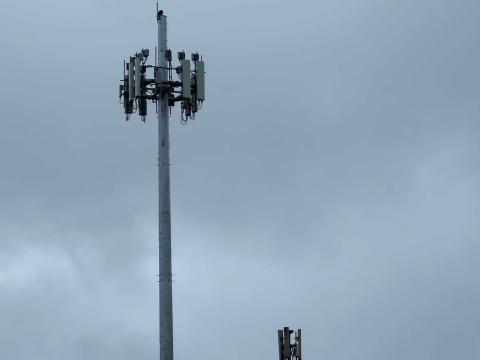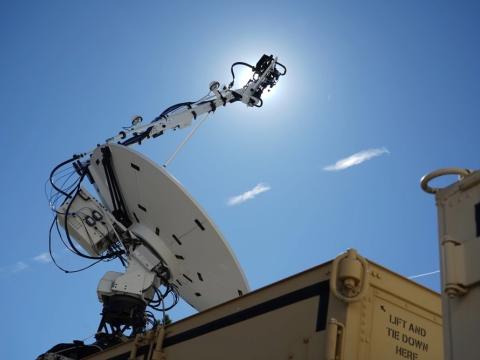Researchers Locate Satellite Options
Military works on strengthening connections from space.
Although global positioning system technologies are being used widely in both the military and commercial arenas, research currently underway could broaden their reach by making the capability better, smarter, faster and less costly. One project, which is near completion, combines inertial navigation with global positioning system navigation to increase effectiveness. The second, a longer term program, is aimed at increasing users’ ability to operate successfully in the face of enemy jammers or countermeasures.
Researchers at the Special Projects Office of the Defense Advanced Research Projects Agency (DARPA), Arlington, Virginia, have been conducting the work on the two programs for several years with an eye on developing and demonstrating technologies for affordable and robust guidance, navigation and control. Applications could include ground vehicles, airborne platforms, air-to-surface weapons and surface-to-surface standoff weapons. The goal is to create technologies that could be retrofitted into existing platforms or be integrated into new packages.
Lt. Col. Gregory J. Vansuch, USAF, is the program manager for both the Global Positioning System (GPS) Guidance Package (GGP) and the GPS Experiments (GPX). While neither of the programs involves revolutionary technologies, they each explore approaches that address current challenges, he says.
The GGP work, which currently is being completed, resulted in the development of a single unit that combines all solid-state miniature inertial measurement unit (MIMU) technologies with a miniature GPS receiver. The box that houses the two elements measures 6 inches by 6 inches by 9 inches and weighs less than 10 pounds.
MIMU accuracy at one nautical mile per hour is less than or equal to 20 meters after loss of GPS signals for four minutes. The miniature GPS receiver was demonstrated by DARPA in 1988. Several technical breakthroughs were made by the commercial sector, including the development of the first hybrid analog/digital microwave monolithic integrated circuit chip and the first all-digital GPS receiver as well as software. The additional work resulted in smaller, more powerful units that have found homes in both commercial and military systems.
Although today’s aircraft carry both the MIMU and miniature GPS receiver instruments, they are separate items. The goal of the GGP project was to design a single unit that is as monolithic as possible and can produce better results than either unit offers individually. The GGP box achieves this objective. If GPS navigation capabilities are lost due to jamming or other events, position and navigation information can be reacquired in approximately three seconds. This is a significant improvement, the colonel relates.
Litton, now a division of Northrop Grumman, Woodland Hills, California, and Honeywell Incorporated, Clearwater, Florida, were the two prime contractors on the work. The final product, while not quite the same as microelectromechanical systems, met the physical robustness and cost goals of the GGP program. To accomplish this, the team developed new manufacturing techniques that were both inexpensive and repeatable.
“This does not solve a unique problem. What it does well is introduce high-grade inertial technologies—navigation grade of one nautical mile per hour—in a size, cost and weight arena that can be afforded,” the colonel says. The reduction in cost creates the possibility of using the unit on platforms such as weapons because it is now expendable, he adds.
The transition of GGP technology from the demonstration stage to insertion into platforms is eminent; however, Col. Vansuch points out that this work is best accomplished through the companies that develop the platforms.
DARPA’s GPX program, which could come to fruition in the 2003 time frame, will increase the ability of GPS users to operate effectively when an adversary engages jammers or other countermeasures. It is exploring technologies that would support the development of high-altitude unmanned aerial vehicle (UAV)-based pseudolites. “We’re working on taking GPS techniques that work and putting them on other platforms,” he says.
Airborne pseudolites, so named because these airborne platforms act as satellites, are rapidly deployed GPS navigation warfare assets. They provide theaterwide coverage to combat the effect of GPS jamming on items ranging from individual soldier units to assault platforms and precision GPS-guided shoot-to-coordinate weapons. The weapons include joint defense attack munitions, joint standoff weapons, the Tomahawk land-attack missile and the standoff land-attack missile–expanded response.
The increased transmission power of the pseudolites enables them to fight off the effects of jamming on U.S. Defense Department receivers. While other approaches to fight jamming exist, they tend to be big and expensive, the colonel states.
However, using UAVs as platforms poses challenges that must be overcome, he explains. “The way GPS works, satellites send a signal that is exquisitely timed. The users on the ground, who know where the satellites are, can figure out where all the satellites were at the time the signal was sent and therefore where they are. The question with airborne pseudolites is how does the user know where the signal came from? Since aircraft move more than satellites, we have to tell the users where the signal came from, and in order to make it simple, we have to do it in the existing datalink. Can we demonstrate that despite this challenge we can provide good navigation? We believe we have solved this problem,” the colonel relates. The capability must still grow in terms of accuracy compared to GPS, but only on the order of 20 percent, he adds.
The second challenge relates directly to the first. The air platform must know its own location so it can relay the information to the ground user. Airborne pseudolite self-positioning must have sufficiently high GPS jam resistance to continue precision self-positioning using the GPS satellites directly throughout jamming activities.
Demonstrations of solutions to these challenges will continue next spring, and the program continues until 2003. At that time, a final demonstration of the pseudolites is scheduled, and GPS-guided weapons may be part of this demonstration, Col. Vansuch relates. Individual services would assist in the transfer of the technology from the research to the acquisition stage.
Col. Roger Robb, USAF, notes that programs such as DARPA’s are examples of work that addresses current GPS issues faced by the Defense Department as it moves toward GPS modernization set for later this decade. Col. Robb is the assistant for GPS plans and programs, space systems directorate, Office of the Deputy Assistant Secretary of Defense for Command, Control, Communications, Intelligence, Surveillance, Reconnaissance and Space, Washington, D.C.
The military’s experience in the Gulf War demonstrated how well GPS supports the coordination of activities and enables domination in the battlespace. In the Kosovo mission, the technology further proved its worth by allowing precision strikes even in inclement weather, Col. Robb adds.
“In Desert Storm, we were looking at weapons that were guided by a laser. That’s very accurate but a relative system. The operator of the platform can designate the target. In Kosovo, when we couldn’t use that kind of technology because of weather conditions, GPS played a larger role,” he explains.
Despite GPS’ attributes, several key issues still must be addressed, including target location error and antijamming (SIGNAL, November 2001, page 57). Col. Robb notes that work currently is underway to improve the targeting of GPS. One aspect is the time lapse between information updates to the satellites. This duration could be shortened. The question that is being asked, the colonel relates, is by how much.
The future of the technology includes GPS Block III; however, an initial operational capability will not be available until the 2016 time frame, Col. Robb explains. In the interim, improvements to the current system continue to be made and will be incorporated on the GPS Block IIR and IIF satellites.
Currently, GPS signals are broadcast at two frequencies: the L-1 at 1575.42 megahertz that is used for both civil and military encrypted signals and the L-2 at 1227.6 megahertz, which services only the military. In the 2003 time frame, a second course/acquisition (C/A)-like code is scheduled to be introduced with the Block IIRM satellites. These would be operational in 2007 or 2008.
In addition, the L-1 and L-2 will be designed to carry a new military code, or M code. Today, the opportunity for jamming is greatest during initial signal acquisition. The M code would address this problem since it is designed to be acquired without reliance on the civil code and ultimately because it will be carried on new high-power spot beams to the L-1 and L-2 channels of military users. However, Col. Robb points out that user equipment would have to be developed to handle the new code. Because M code initial operational capability will not be available until 2008, he notes that developers have time to design the user equipment so that both the satellites and compatible user equipment enter service concurrently.
The final new frequency planned for the future would be the L-5 at 1176.45 megahertz. This would be a safety-of-life signal, the colonel explains, and would be used by civil aviation and other safety-of-life applications. This capability should be fully operational in the 2014 timeframe.
Even with a multitude of improvements, GPS technology cannot solve problems under all conditions. “Although GPS Block III will have increased accuracy, it probably will never provide full access in all kinds of environments such as urban warfare. Those are things we have to look at. Frequency is difficult to acquire, and it may not be a problem we can solve strictly from space,” Col. Robb submits.




Comments